



Supreme Court Cases | BRI’s Homework Help Series Playlist
31 items

Baker v. Carr | Homework Help from the Bill of Rights
Video
Video
5 Min
In this Homework Help video, learn the story of the landmark Supreme Court case of Baker v. Carr. The case explores the question of a state’s right to control electoral lines otherwise known as gerrymandering.
The case ruling concluded that the Supreme Court could hear cases pertaining to redistricting because of the Equal Protection Clause in the 14th Amendment through the process of incorporation which argues that states must adhere to the protections of guaranteed in the Bill of Rights. How did the ruling in this case contribute to the democratic principle of “one person-one vote”?
5 Min

Brown v. Board of Education | BRI’s Homework Help Series
Video
Video
4 Min
Brown v Board of Education was a case brought to the Supreme Court in 1954 after Linda Brown, an African American student in Kansas, was denied access to the white-only schools nearby her house. Future Supreme Court Justice Thurgood Marshall was the lawyer for the case, and argued that segregated schools were inherently unequal. Ultimately, the Supreme Court ruled in favor of Linda Brown and declared segregation unconstitutional under the Equal Protection Clause of the 14th Amendment through incorporation under the premise that the bill of rights also applies to the states. This is one of the landmark cases that led to the passage of the Civil Rights Act of 1964.
4 Min

Bush v. Gore | BRI’s Homework Help Series
Video
Video
7 Min
Why was the presidential election of 2000 so controversial, and what constitutional questions were raised during the vote count? This Homework Help video explores these questions to help students understand the fundamental issues at hand in the case of Bush v. Gore.
7 Min

Citizens United v. FEC | BRI’s Homework Help Series
Video
Video
4 Min
Citizens United v. FEC was a Supreme Court case surrounding campaign finance and corporate involvement in politics. The Federal Election Commission was created in 1971 and greatly regulated the amount of campaign finance political candidates were able to receive. By 2002, the Bipartisan Campaign Finance Reform Act (McCain-Feingold Act) restricted organizations from financing issue-based advertisements on behalf of candidates. Citizens United released a million dollar ad against Hillary Clinton. Before the film aired, Citizens United challenged the McCain-Feingold Act, stating that money was a form of Free Speech, which is protected by the First Amendment. The Supreme Court ruled the McCain-Feingold Act as unconstitutional, but stated that corporations still cannot give money directly to political candidates.
4 Min
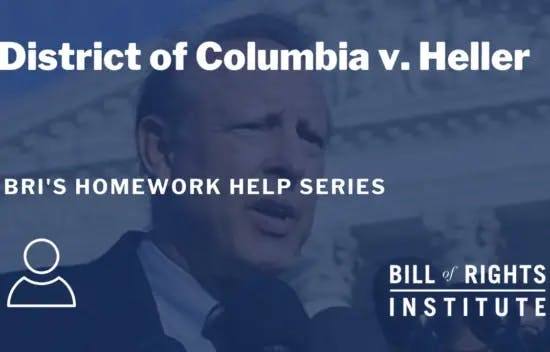
District of Columbia v. Heller | BRI’s Homework Help Series
Video
Video
Does the 2nd Amendment protect an individual or a collective right to bear arms? Find out the answer to this question in the latest episode of BRI's Homework Help Series on the case of District of Columbia v. Heller. 2008 Supreme Court case

Dred Scott v. Sandford | Homework Help from the Bill of Rights Institute
Video
Video
3 Min
The Dred Scott v. Sandford case of 1857 was brought to the Supreme Court just four years before the start of the Civil War. Dred Scott sued his master for his freedom and Judge Robert Taney ultimately ruled two things. First, African Americans were not citizens and had no right to sue in court. Second, Congress did not have the constitutional authority to ban slavery from the states. This case is considered one of the worst rulings in the history of the Supreme Court.
3 Min
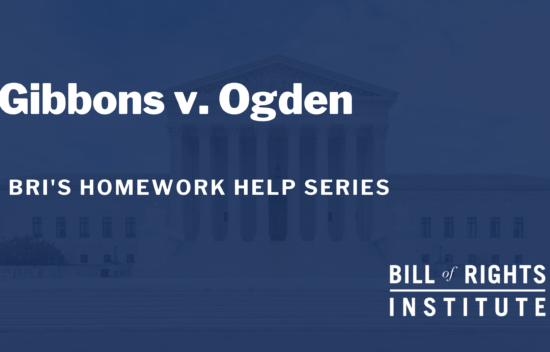
Gibbons v. Ogden | BRI’s Homework Help Series
Video
Video
3 Min
Gibbons v. Ogden was a Supreme Court case dealing with interstate commerce. In 1824, New York created a law that granted Aaron Ogden a monopoly over steamboat access to the Hudson River. Thomas Gibbons held a federal license to operate his steamboat between New York and New Jersey. Gibbons won unanimously through his connection of the Interstate Commerce Clause and Supremacy Clause. New York’s law was overturned and Gibbons, along with other steamboat operators were able to participate in Interstate Commerce via waterways.
3 Min

Gideon v. Wainwright | Homework Help from the Bill of Rights Institute
Video
Video
4 Min
Does an individual have a right to a lawyer, regardless of the crime he or she is charged with? In 1961, Clarence Gideon was arrested and charged with breaking and entering and petty larceny in Panama City, Florida. His request for a state-provided defense attorney was denied since Florida law only required doing so for capital offense cases. After Gideon was sentenced to 5 years in prison, he argued that Florida violated the 6th Amendment’s guarantee of the right to counsel. The Supreme Court heard Gideon’s case, in Gideon v. Wainwright, and ruled in a 9-0 decision that the 6th Amendment’s guarantee of an attorney applies to states through the Due Process Clause of the 14th Amendment through incorporation.
4 Min

Grutter v. Bollinger | BRI’s Homework Help Series
Video
Video
4 Min
Grutter v. Bollinger was a case brought to the Supreme Court over the use of Affirmative Action in the college admissions process. The University of Michigan Law School denied acceptance to Barbara Grutter, despite her impressive resume. Grutter, a white woman, believed that her rejection was based on her race. The Supreme Court Justices ultimately ruled that the University of Michigan Law School’s admissions process was constitutional and did not violate the Equal Protection Clause in the 14th Amendment. Incorporation, the process of states being held liable to the Bill of Rights, allowed the Supreme Court to hear and rule on the case.
However, there was doubt among the most conservative Supreme Court justices like Scalia and Rehnquist that affirmative action policy was a constitutional practice for university admission departments to take part in. Affirmative Action is still a highly debated topic today.
What is Affirmative Action? Affirmative Action is a policy, usually carried out by schools, businesses, government entities, and federal contractors, in which individuals of minority racial status are afforded preferential treatment on the basis of race. Affirmative action came about as part of a desire to rectify the traditional underrepresentation of minority peoples in desirable professions and universities, which negatively impacted their financial and social conditions.
4 Min

Engel v. Vitale | BRI’s Homework Help Series
Video
Video
6 Min
Is school-sponsored prayer in public schools a violation of the establishment clause of the First Amendment? In 1951, some New York schools began starting the day with a non-denominational prayer. This Homework Help video tells the story of the ensuing landmark Supreme Court case of Engel v. Vitale.
6 Min
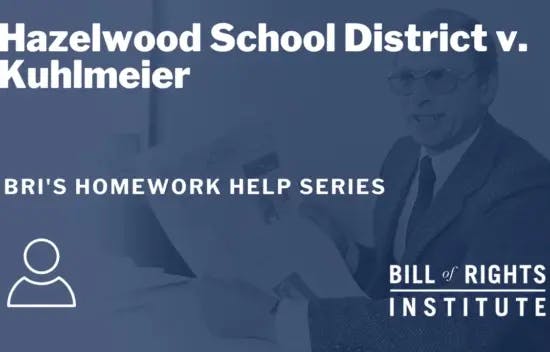
Hazelwood v. Kuhlmeier | BRI’s Homework Help Series
Video
Video
What free speech rights do you have as a student? In the Hazelwood v. Kuhlmeier (1988) Supreme Court ruling, the court found that articles written in the school newspaper are not subject to 1st Amendment, freedom of speech rights for student journalist. Learn how the court came to this answer in the latest episode of BRI's Homework Help Series on the case of Hazelwood v. Kuhlmeier.
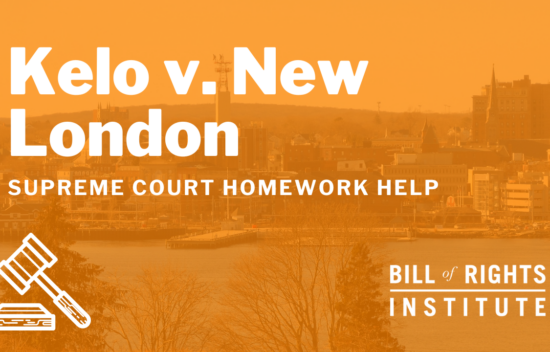
Kelo v. New London | BRI’s Homework Help Series
Video
Video
6 Min
Under what circumstances can the government take your property? In 2005, the Supreme Court took on this question in the case of Kelo v. New London. The court argued about whether applying the 5th Amendment to the states using the Due Process Clause of the 14th Amendment was constitutional or unconstitutional. This process is referred to as incorporation. Our latest Homework Help video reviews the details of the case and encourages students to analyze the decision to form their own opinions.
6 Min

Mapp v. Ohio | BRI’s Homework Help Series
Video
Video
5 Min
Can the police use illegally seized evidence in a court of law? The landmark Supreme Court case Mapp v. Ohio addressed this issue, and the decision has had a lasting impact in the United States.
5 Min

Marbury v. Madison | BRI’s Homework Help Series
Video
Video
3 Min
Marbury v. Madison was the Supreme Court case that established judicial review. William Marbury was a judge appointed at the end of John Adams’ presidency, but never got his official commission papers. Once Thomas Jefferson became president, James Madison refused to deliver the commission papers. Marbury took his case to the Supreme Court and wanted a Writ of Mandamus, requiring Madison to deliver the papers. Ultimately, the court stated that Marbury was entitled to his papers, but it was unconstitutional for the courts to issue a Writ of Mandamus. Thus, judicial review was created and the principle of checks and balances was strengthened.
3 Min

McCulloch v. Maryland | BRI’s Homework Help Series
Video
Video
4 Min
McCulloch v. Maryland was the 1819 Supreme Court case dealing mostly with the issue of Federalism. The creation of a National Bank was encouraged by Alexander Hamilton, but opposed by Thomas Jefferson, due to lack of authority given by the Constitution. A National Bank was chartered, but then died 20 years later. In 1816, a National Bank was re-instated to help deal with debts from the War of 1812. This Second National Bank, established in Maryland, was taxed heavily by Thomas Jefferson and the State of Maryland. Federal Bank Cashier, James McCulloch, refused to pay the tax, stating that the state did not have the right to tax an institution of the Federal Government. Ultimately, the Supreme Court stated that Congress had the right to create the National Bank, under the Necessary and Proper Clause. Also, the State of Maryland did not have the right to tax the National Bank and the Federal Government under the Supremacy Clause.
4 Min
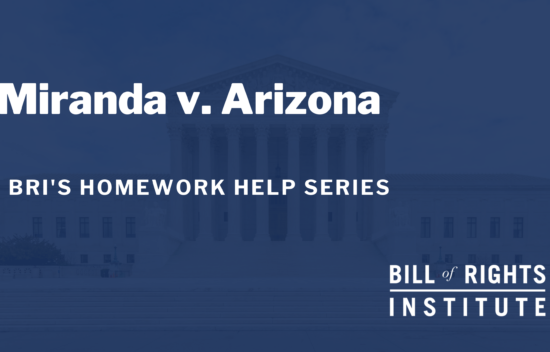
Miranda v. Arizona | BRI’s Homework Help Series
Video
Video
3 Min
Miranda v. Arizona was a case brought to the Supreme Court in 1966 after Ernesto Miranda appealed his guilty conviction of kidnapping and rape. In his appeal, Miranda claimed he was unaware of his right to remain silent and his resulting confession should not be used to incriminate him. The Supreme Court ruled in favor of Miranda and established the Miranda Warning. This warning is now recited in most instances of arrest to ensure the accused people are aware of their rights.
3 Min
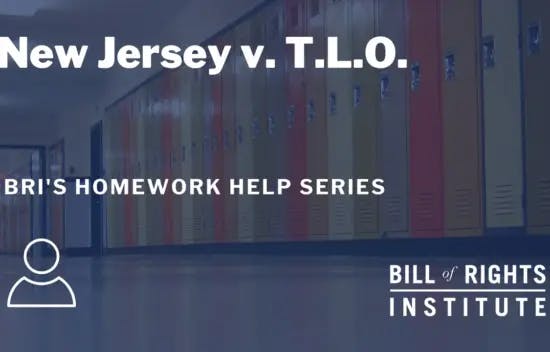
New Jersey v. T.L.O. | BRI’s Homework Help Series
Video
Video
The New Jersey v. T.L.O. (1985) Supreme Court case questions if school officials can randomly search student property while at school under the 4th Amendment? Find out the answer to this question in the latest episode of BRI's Homework Help Series on the case of New Jersey v. T.L.O.

New York Times Co. v. United States | BRI’s Homework Help Series
Video
Video
6 Min
How to best balance liberty and security has been a perennial question throughout U.S. history. This Homework Help video explores how the Supreme Court addressed this question in the landmark case of New York Times Co. v. United States.
6 Min
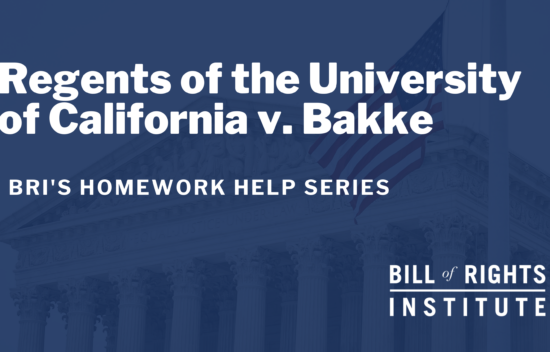
Regents of the University of California v. Bakke | BRI’s Homework Help Series
Video
Video
4 Min
Regents of the University of California v. Bakke was a case brought to the Supreme Court over the use of Affirmative Action in the college admission process. The University of California at Davis Medical School created a minimum minority student quota for the admissions department to fill each year. Bakke, a two-time UC-Davis Med School rejected applicant, sued the school for violation of the Equal Protection Clause of the 14th Amendment and Title VI of the Civil Rights Acts. Ultimately, the Supreme Court justices ruled in support of the goals of Affirmative Action because of incorporation, the idea that the states must adhere to the protections of the Bill of Rights. They also stated that Bakke was, in fact, denied equal protection. This decision, because it was so muddled, did not set long-term precedents or clarifications concerning Affirmative Action.
What is Affirmative Action? Affirmative Action is a policy, usually carried out by schools, businesses, government entities, and federal contractors, in which individuals of minority racial status are afforded preferential treatment on the basis of race. Affirmative action came about as part of a desire to rectify the traditional underrepresentation of minority peoples in desirable professions and universities, which negatively impacted their financial and social conditions.
4 Min
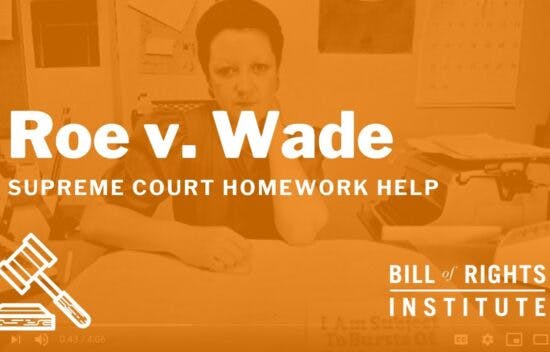
Roe v. Wade | Homework Help from the Bill of Rights Institute
Video
Video
4 Min
Do women have a right to privacy when deciding whether to have an abortion? In 1969, a woman under the alias “Jane Roe” challenged a Texas law that outlawed abortions. The case eventually reached the Supreme Court, where Roe argued that the Constitution protects a woman’s right to privacy in having an abortion. In a 7-2 decision, the Court ruled the right to an abortion fell within the right to privacy protected by the 14th Amendment’s Due Process Clause.
Like other Supreme Court cases related to the Due Process Clause, incorporation played a part in the Roe v. Wade ruling. Incorporation suggests that states must adhere to the protections granted in the Bill of Rights.
To this day, the ruling in Roe v. Wade remains one of the most controversial Supreme Court decisions.
4 Min

Plessy v. Ferguson | BRI’s Homework Help Series
Video
Video
5 Min
How did the odious doctrine of “separate but equal” become legally permissible in the U.S.? This Homework Help narrative explores the story of the Plessy v. Ferguson Supreme Court case. Further, analyze how the idea of “separate but equal” violates the Equal Protection Clause of the 14th Amendment through incorporation that was later struck down in the 1954 Brown v. Board of Education Supreme Court Case championing the passage of the Civil Rights Act of 1964. Due to the process of incorporation, the Supreme Court was able to eventually rule that the states had to adhere to the protections listed in the Bill of Rights.
5 Min
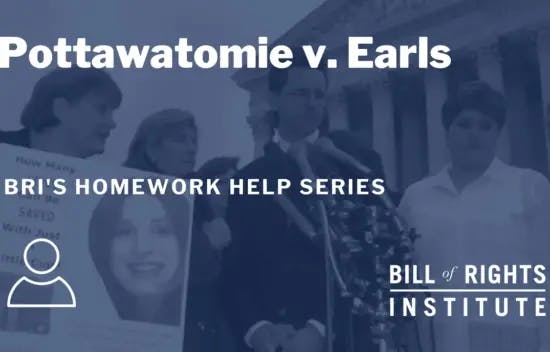
Pottawatomie v. Earls | BRI’s Homework Help Series
Video
Video
What rights do American students have in regards to drug testing in schools? Find out the answer to this question in the latest episode of BRI's Homework Help Series on the case of Pottawatomie v. Earls.
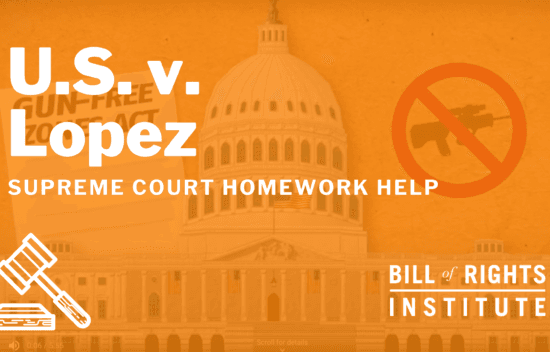
U.S. v. Lopez | BRI’s Homework Help Series
Video
Video
6 Min
This Homework Help narrative explores the landmark case of U.S. v. Lopez and its lasting impact on federalism. Students will study the topic of federal power and street crime while forming their own opinions on the merits of the case.
6 Min
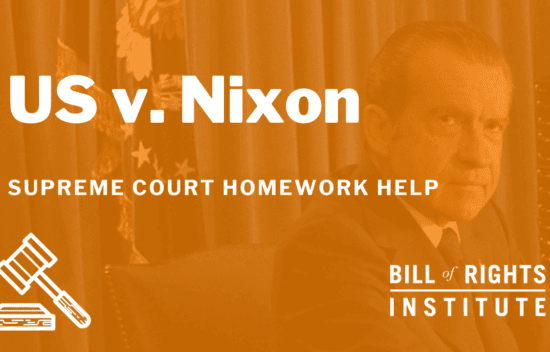
United States v. Nixon | BRI’s Homework Help Series
Video
Video
4 Min
Can the President of the United States withhold certain information from Congress and the courts? During the Watergate Scandal, President Richard Nixon attempted to withhold recording tapes from the White House from investigators. The Supreme Court’s ruling would have huge impacts on the system of checks and balances within the United States' governing system.
4 Min

Schenck v. United States | BRI’s Homework Help Series
Video
Video
3 Min
Schenck v. United States was a Supreme Court Case that explained some limits to the Freedom of Speech afforded by the First Amendment. During World War I, the US instituted a military draft. Many people released anti-war and anti-government information due to their displeasure with the draft. Charles Schenck, an anti-war socialist, was arrested by the Federal Government for circulating a pamphlet encouraging men to resist the draft and violating the Espionage Act of 1917. The Supreme Court ruled that wartime circumstances changed the rules related to free speech and resulted in the “Clear and Present Danger” rule.
3 Min
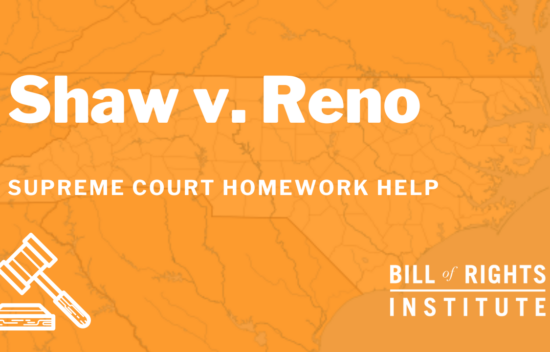
Shaw v. Reno | BRI’s Homework Help Series
Video
Video
5 Min
Can a state draw district lines to increase the voting power of a minority? The Supreme Court took up this question in the 1993 case of Shaw v. Reno. Following the 1962 Baker v. Carr Supreme Court case, which ruled that the Supreme Court could hear cases on gerrymandering because of the Equal Protection Clause in the 14th Amendment through the process of incorporation, Shaw v. Reno challenged the constitutionality of gerrymandering based on race. Check out our latest Homework Help video on this AP Government required Supreme Court case!
5 Min
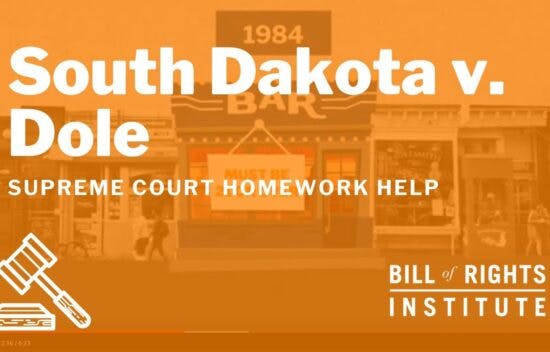
South Dakota v. Dole | BRI’s Homework Help Series
Video
Video
7 Min
Why is the drinking age set at 21? This Homework Help video explores the dispute between states and the federal government over the legal age, and how it is an example of the principle of federalism in action.
7 Min

Texas v. Johnson | BRI’s Homework Help Series
Video
Video
Should burning the American flag be considered a form of expression protected by the First Amendment? Learn how the Supreme Court addressed this controversial question in the case of Texas v. Johnson.
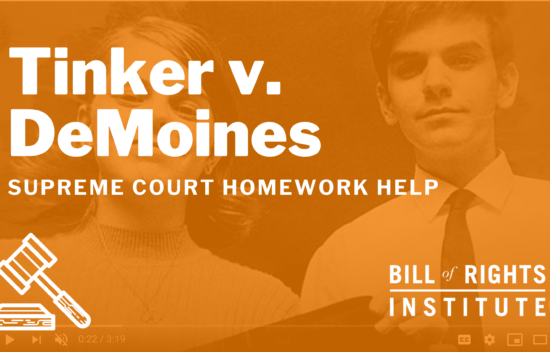
Tinker v. Des Moines | Homework Help from the Bill of Rights Institute
Video
Video
3 Min
Why did a subtle act of protest against a foreign war reach the Supreme Court? In 1965, students John and Mary Beth Tinker wore black armbands to school to protest the United States’ involvement in the Vietnam War, despite the Des Moines school district prohibiting such an act. The Tinkers sued the district for violating their First Amendment rights, and the Supreme Court ruled in their favor in a 7-2 decision. While subsequent Supreme Court rulings narrowed the scope of free expression rights at school, Tinker v. Des Moines remains a landmark case that has defined First Amendment rights for students.
3 Min
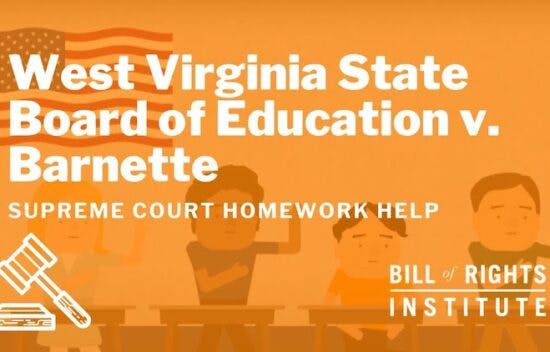
West Virginia State Board of Education v. Barnette | BRI’s Homework Help Series
Video
Video
1 Min
Should students be required to salute the flag? In 1943, the Supreme Court heard a case after Jehovah's Witnesses in West Virginia refused to comply with a school board policy requiring they salute the U.S. flag during the Pledge of Allegiance. How did the Court rule? Find out with our latest Homework Help video!
1 Min

Wisconsin v. Yoder | BRI’s Homework Help Series
Video
Video
6 Min
Religious liberty is one of the foundational principles of American society, but how should it be balanced with government interests in an educated citizenry? Our second Homework Help video of the semester is on the landmark case of Wisconsin v. Yoder, and how the Supreme Court dealt with this important question.
6 Min